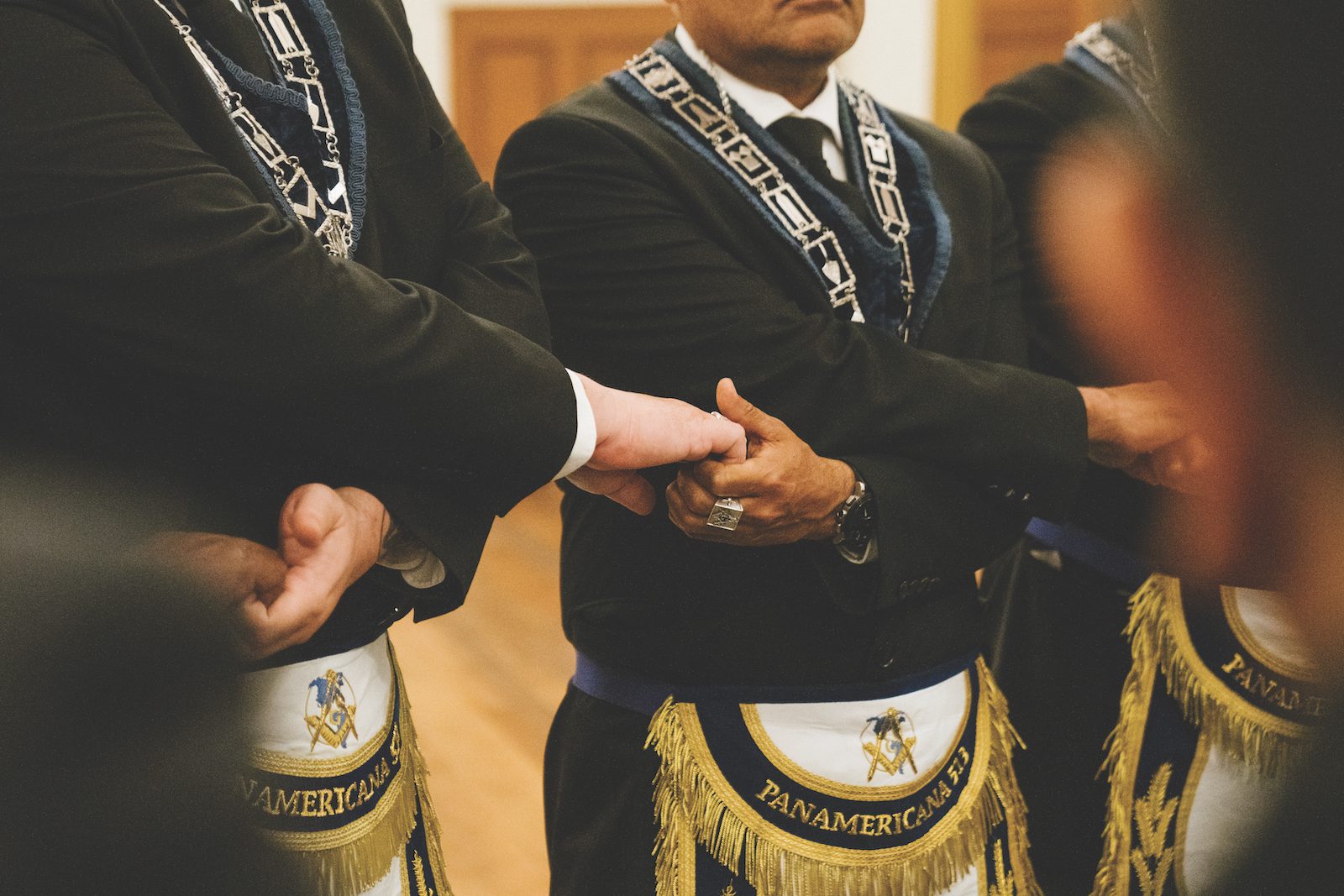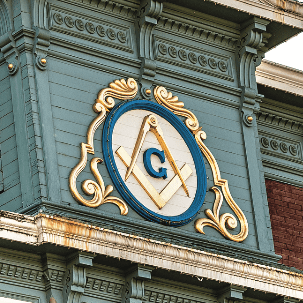
In California’s Spanish-Speaking Lodges, a Masonic Culture Club
For members of California’s two official Spanish-speaking Masonic lodges, the sense of brotherhood is twice as strong.
Saul Alvarado already had a good idea about what Freemasonry was capable of, even before he joined it. He’d seen the effect it had on his father-in-law’s life, how it helped him navigate sobriety. But as he read up on the fraternity, he began to learn more about the importance of Freemasonry in Mexico. Just as the founding fathers of the United States were Freemasons, so too were the heroes of the Mexican Revolution and the War of Independence. “It was like, wait a second, Mexico has Masons, too?” he recalls thinking. “That really gave me the nudge to learn more. It made me want to get more involved.”
Alvarado isn’t the only person who’s felt that pull of kinship. Freemasonry in Mexico has a long and distinguished history. That said, it’s one that for many people in California—including many Mexican American Masons—largely remains a mystery. Yet it’s also an enormous opportunity. That’s because to many people, including Alvarado, Freemasonry can be seen as an important way to forge connections across borders and deepen their understanding of their culture and history. “Learning about all these figures who were Masons, it opens you up in a different way,” Alvarado says. “It opens another dimension of pride.”
Mexican Masonry isn’t just a quirk of history. Rather, it remains alive and well south of the border. In fact, Mexican Masonry continues to thrive in enclaves throughout California, Texas, and the Southwest, as it has for more than a century. Increasingly, California Masons are looking for opportunities to highlight that tradition and support the growth of Latino participation more broadly. According to Alvarado, “We need to extend this. We need to open Masonry up to the Latino community and celebrate what Freemasonry has meant to our heritage.”
This July, a group of Masons in Mexico and California will attempt to do just that. Representatives from the Masonic grand lodges of California, Baja California, and Baja del Sur will meet in San Diego for the yearly Conference of Three Californias, which has taken place every year since 1979.
The conference is an opportunity to share new developments and best practices, says Arturo Sevilla, the grand secretary of the Grand Lodge of Baja California. It’s also a way to celebrate an important Masonic partnership that transcends borders. The highlight of the event is a degree presentation put on by the host lodge. For those in attendance, being able to sit together in that setting is a powerful reminder of the global bonds tying members together. “It’s good to know how Masonry operates outside our borders,” Sevilla says. “It makes our Freemasonry more cosmopolitan.”
As lodges begin to envision a post-pandemic future, the conference is also serving as a sneak preview of the next iteration of Masonry in Mexico and California. “Moving forward, as we’re talking about ways to adapt to improve diversity and inclusion in California, I see this as an important step,” says Arthur Salazar. As junior grand warden, Salazar is on track to become California’s first Latino grand master. “We can build so much more when we welcome other cultures within our communities,” he says. “I see this as a challenge and an opportunity.”
An important step in meeting that challenge is saluting the deep Masonic legacy found within those members’ cultures, he says. For many Masons, that’s a real point of pride.
Above:
Members of Logia Simbólica Cuauhtémoc Nº 15 in Tijuana—a sister lodge of La Jolla Nº 518—pose for an Instagram moment. Photo by Matthew Reamer.
The story of Freemasonry in Mexico is practically inseparable from the country’s political history. The craft first arrived there in the late 18th century through Spanish military lodges. The first permanent Mexican lodge was formed in 1806, and within a few years several more had been established. The early Mexican Masonic lodges were made up primarily of the country’s European-born ruling classes. It was in these lodges that much of the liberal Enlightenment views of the time were propagated throughout the country.
By the end of the War of Independence in the early 1820s, a growing network of Masonic lodges had been installed in Mexico. From the very beginning, however, Mexican Masonry was weighted with the political rivalries that would dominate the country for the next hundred years. In lieu of traditional parties, Mexico’s political battles played out in lodge rooms. Typically, Scottish Rite lodges tended to represent the centralists. (Conservative, Catholic, aligned with Europe.) Meanwhile, the liberal federalists gravitated toward lodges working under the York Rite or the Mexican National Rite. (Pro-democratic, anticlerical, aligned with the United States.) Each side’s political hierarchy was essentially reproduced within the respective lodges. From Benito Juárez and Porfirio Díaz to Francisco Madero and Lázaro Cárdenas, nearly every president of Mexico for 100 years belonged to one of the dueling Masonic bodies.
That connection became even more pronounced during the Mexican Revolution of 1910–20. In 1929, President Emilio Portes Gil, a future grand master of Mexico, declared that the “state and Freemasonry in Mexico had become the same thing.”
That’s no longer the case. In the decades following the Mexican Revolution, Masonry began to recede from the public spotlight. Lodges became less involved with government affairs, and their influence in civic life waned. Unsurprisingly, the Masonic population in Mexico has also dwindled. In 1929, one estimate suggested a membership of about 10,000 Masons in Mexico, out of a population of 17 million. Today that figure is nearly 20,000 (not counting irregular lodges, of which there are several) out of a population of 128 million. That’s about about a quarter of its relative size a century ago.
Masonic jurisdiction in Mexico is now divided between 31 state-level grand lodges and a separate national grand lodge. Despite that patchwork of organizing bodies, Sevilla says, Freemasonry in Mexico today hardly resembles the factional hothouse it was for most of its history.
Still, Mexican Freemasonry retains a distinct flavor—one quite unlike what’s practiced in the United States. The first and most obvious difference is the ritual. California and most U.S. lodges use the Preston-Webb ritual, which bears some similarity to the York Rite’s craft degrees. While the York Rite still exists in Mexico, today the vast majority of lodges issue the first three degrees of the Scottish Rite. Also, Mexican Masonry places enormous emphasis on esotericism and philosophical study, says Andres Francisco Leon. He is a member of the Grand Lodge of Tamaulipas and past master of Cedros del Libano № 79 in Nuevo Laredo, just across the border from Texas. Candidates often spend years progressing through the degrees and are expected to produce written essays demonstrating their understanding of Masonry. Additionally, lodge rooms in Mexico tend to be more elaborately furnished than those in the United States, he says. Many lodges feature the signs of the zodiac painted onto brightly colored walls.
However, for all that grandeur, “Masonry in Mexico tends to be very solemn,” says Daniel Velazquez, the grand chancellor of the Gran Logia Occidental Mexicana in Jalisco and a member of Jacques DeMolay № 52 in Guadalajara. “Most lodges I’ve attended, they get mad if you cross your legs or take out your cell phone. It’s a very serious place.”
Above:
Window to another world: A special view inside the Oaxaca Masonic Temple of the Gran Rito Nacional Benito Juarez. Photo by Luvia Lazo.
Despite their proximity and shared history, for generations the fraternity in California was not especially welcoming to its southern neighbors. Until fairly recently, few Mexican Masons were ever admitted into California’s lodges.
While membership has never been formally closed to anyone on the basis of race, nationality, or ethnicity, Masonic lodges have historically reflected many of the same prejudices found elsewhere in society. Because lodges didn’t keep records of members’ ethnicity, it’s impossible to track Latinos’ historic share of overall membership. But during the early and middle part of the 20th century, it was sufficiently small that Leon Whitsell, in his study One Hundred Years of Freemasonry in California, pointed out that Golden Rule № 479 in San Jose was “one of the relatively few lodges to have a native Hispanic Californian on its rolls. And it has not one, but two.” That was in 1950.
Though lacking visibility with the Grand Lodge of California, Mexican Masonry has long flourished in the state, particularly around Los Angeles, where for decades so-called “irregular” Masonic lodges have existed. These lodges have different traditions and rules than do those organized under the Grand Lodge of California. As such, members of the two bodies are not allowed to sit in on one another’s meetings. For much of the 20th century, however, irregular lodges were the source of practically all Masonic activity among certain ethnic groups in California—particularly in Black, Latino, and Filipino communities.
In 1930, the Grand Lodge of California published a study in the Proceedings of the Grand Lodge of these so-called irregular, or ethnic, lodges. That year, it identified 20 Mexican lodges organized under the Supremo Gran Oriente del Rito Nacional Mexicano. Another three groups were part of the Grand Lodge Benito Juarez of Torreon, which in 1932 appealed to the Grand Lodge of California for formal recognition. Later, a splinter group of the Mexican National Rite established a series of lodges from San Pedro to San Francisco, while a women’s lodge, or logia de adopción, was constituted in Los Angeles. (Women’s and co-ed Masonry have a long history within the Mexican National Rite.)
Despite being short-lived, the irregular Mexican lodges represented a sizable group of Masons in California. In 1936, the Grand Lodge reported that one such group, Plaridel № 30 of Los Angeles, held “fraternal relations with no less than 750 foreign lodges.”
Over time, more Mexican and Mexican American Masons began entering California blue lodges. So in 1946, a special committee recommended that the Grand Lodge of California establish its own Spanish-speaking lodges to serve the growing Mexican American Masonic community. “Our investigations of the personnel of some of these [irregular] groups lead us to believe that many of their members are of good Masonic material,” it reported. The motion, however, was not passed. It would be another decade before the next breakthrough.
Above:
Grand Master of the State of Baja California Armando López Acosta presides inside Logia Simbólica Cuauhtémoc Nº 15 in Tijuana. Photo by Matthew Reamer.
Eventually, that moment arrived. In 1959, Grand Master Phil Myers issued a dispensation to Maya Lodge № 793 in Los Angeles. Though the lodge would perform the ritual in English, it was envisioned as a haven for primarily Mexican American members. It wasn’t until 1993 that it received special permission to perform its first degree ceremony in Spanish.
In 2005, a dispensation was issued for a second Spanish-speaking lodge, Panamericana № 849. (In 2008, it consolidated into Panamericana № 513.) A third Spanish-speaking lodge emerged in 2017, Fraternidad de los Americas № 867, though its charter was later revoked.
Through those lodges, Latinos have increasingly established themselves within California Masonry. In 2020, a survey determined that 23 percent of California members were of Latino descent. That figure includes Filipino members with Hispanic surnames, so the true membership descending from Latin American countries is likely lower. Either way, it’s well short of the state’s overall demographics, but also a far cry from the early days.
In addition to those members, California Masonry includes an estimated 35 irregular Mexican-style lodges, which serve an almost exclusively Latino membership. For many, there’s a sense of hope that the next chapter of Masonry in the state will include finding a way to incorporate those members. “We have a great opportunity to welcome them into the fold,” one California member says. “They want and need the structure of the grand lodge, and they come with a wealth of knowledge. It would benefit us all.”
Salazar has spent a lot of time thinking about that issue. Increasing the diversity in California’s lodges, especially among Latinos, is key to strengthening the fraternity, he says. That hasn’t always been easy. Salazar says even he was initially skeptical about approaching a lodge, since so few of its members looked like him. While much has changed since then, Salazar believes there’s plenty of room to grow. “When I think about diversity, it’s not about recruiting for the sake of a quota,” he says. “We’re talking about making sure every part of our community knows we bring something of value. If our Latino community hears that message, I think it will resonate.”
Above:
A Masonic lodge officer in Tijuana shows off his regalia. Photo by Matthew Reamer.
That’s why Salazar is bullish on the Conference of Three Californias and other partnerships like it. An international connection is a powerful idea for many members, especially those with family on both sides of the border. More and more, it’s a bond that members are experiencing. Examples of California and Mexican Masons supporting one another are increasingly common. Many Southern California lodges have even established sister-lodge programs with their Mexican counterparts. Among them are El Centro’s Imperial Valley № 390 (who have partnered with Palingensia № 46 of Mexicali) and La Jolla № 518 (who have also partnered with Logia Simbólica Cuauhtémoc № 15 in Tijuana). Others, including Downey United № 220 and La Mesa № 407, have similar partnerships.
Says Salazar, “When I look at the larger picture of Freemasonry, it’s wonderful to know you can travel to any country, any state, and be welcomed. It shows our lodges that there’s nothing to be feared from inviting other cultures into our experience.”
Velazquez has seen that up close in his travels throughout Mexico and the United States. It’s left him with an ever deeper appreciation for Freemasonry. “When you go to a lodge in another country and see someone you haven’t met before, he’s going to call you a brother,” Velazquez says. “It makes you feel like you’re part of something that’s very ancient and very big. So I feel like I have a responsibility to keep it going and to keep it great.”
Above:
Grand Master Tomas Galguera inside the Oaxaca Masonic Temple of the Gran Logia Benito Juárez García. Photo by Luvia Lazo.
PHOTOGRAPHY BY:
Matthew Reamer and Luvia Lazo

For members of California’s two official Spanish-speaking Masonic lodges, the sense of brotherhood is twice as strong.

Led by ‘The Pentaverate’ and ‘The Lost Symbol,’ allusions to secret fraternal organizations based on Freemasonry are suddenly everywhere.

How Napa Valley Masonic Lodge No. 93 used its greatest asset—the impressive Ritchie Block building in St. Helena—to pay it forward.